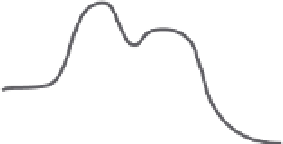Geology Reference
In-Depth Information
Incision of
Kings Canyon
0.3
Ca
ve-deriv
ed rate
4
0.2
Range-wide
mean
Modern profile
Post-uplift
model proile
3
0.1
Cave-derived rate
0.0
Metamorphic
belt
2
65
4
3
2
1
0
Time (Ma)
Final model
profile
Steady-state
profile
Central Valley
1
Caves
West
East
0
20
40
60
80
100
120
140
Distance (km)
Fig. 11.13
Rejuvenation of Kings River, Sierra Nevada.
Response of South Fork Kings River to late Cenozoic tectonic and climatic events. Example of stream-power-based
numerical simulation. Steady river profile (dashed) with steps corresponding to quartzite in two metamorphic belts is
subjected to
∼
1.5 km of crestal uplift, causing a tilt, down to the west. Model profiles at 1-Myr intervals (thin gray
lines) show that, over the next 9 Myr, a wave of rapid incision begins at the hinge line and propagates up-river. (Inset)
The 6-Myr incision history at the cave site where cave dates have been constrained from
10
Be burial age methods.
A wave of rapid incision passes between about 5 and 2 Ma, followed by return to low pre-uplift rates (dashed curve
after 2 Ma). Further reduction in late Quaternary rates (solid curve after 2 Ma) reflects sediment mantling of bed
associated with large glaciers in headwaters. Final modeled river profile (gray dashed line) fits modern profile (black)
to just upstream of cave site, above which glacial erosion, not represented in the river incision rule, has dominated the
past few million years. Modified after Stock
et al.
(2004).
glacier varies strongly over Quaternary times. But
several other key points were illustrated by the
modeling exercise. First, straths can be aban-
doned progressively, resulting in a spread in the
abandonment age of a surface. This spread
reflects the wave of sediment thinning in the
aftermath of sediment supply reduction in the
headwaters. Second, the mean rate of incision
one deduces from dividing the height of a terrace
by the age of the terrace can vary greatly (see
Box 7.2). Given when we live, in the midst of an
interglacial, soon after the abandonment of the
Last Glacial Maximum (LGM) strath, the rate we
are likely to deduce from the LGM terrace is
probably higher than that we would deduce from
older straths. Whereas some workers have inter-
preted such age structure to signify acceleration
of rock uplift, it is not necessarily so. Despite
being driven by a perfectly sinusoidal sediment
and water supply (Fig. 11.12A), the model results
indicate that the formation and abandonment of
straths is not a steady process. Rather, it is very
spotty in time, with long periods of lateral incision,
punctuated by short periods of vertical incision.
Interpretation of strath records for any rock
uplift signal must, therefore, be done with full
attention to the punctuated nature of incision.
Caves as straths internal to a mountain
In a twist to the strath story, several researchers
have demonstrated that caves in the walls of
gorges can serve the same role as strath terraces
in allowing documentation of incision rates (e.g.,
Granger
et al
., 1997, 2001). Stock
et al
. (2004)
employ multiple caves in the walls of King's
Canyon in California to document a record of
incision history that displays a striking reduction
of incision rate toward the present (Fig. 3.21):
rates between 3 and 1 Ma are 0.15-0.25 mm/yr,
whereas those from 1 Ma to present are an order
of magnitude slower (Fig. 11.13). A numerical
model of river incision was employed to test
whether this reduction was consistent with
tilting of the range deduced from other
geomorphic and stratigraphic evidence. We have
discussed the underlying cause of this late
Cenozoic tilting in Chapter 10 (Fig. 10.45). Stock






















































